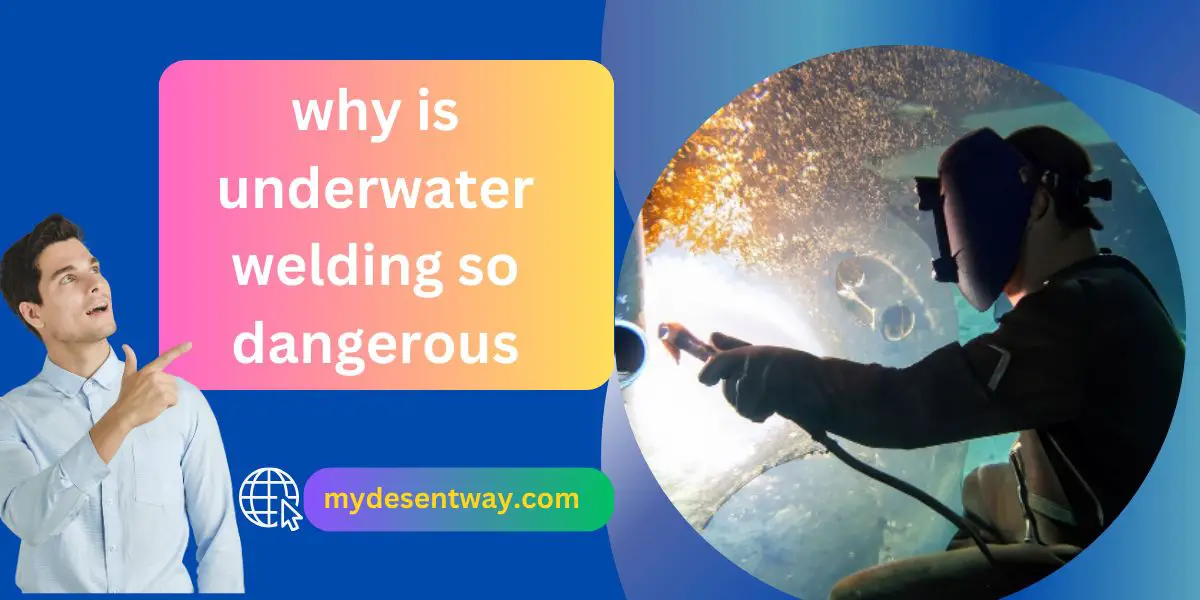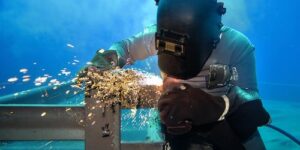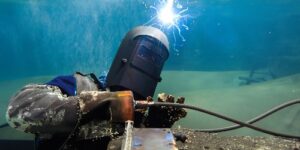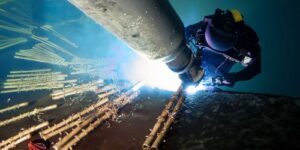Table of Contents
- Why is underwater welding so dangerous?
- 1. What is underwater welding?
- 2. Understanding the Perils
- 3. Risk Factors and Their Implications
- 4. Injuries and Fatalities
- 5. Safety Solutions and Precautions
- 6. Future Prospects and Innovations
- 7. Decision to Pursue Underwater Welding
- 8. Legal and Support Aspects
- Is underwater welding dangerous and risky?
- Why Would You Choose Underwater Welding If It Is So Dangerous?
- How long does it take to become an underwater welder?
- Do underwater welders make six figures?
- Is underwater welding a hard job?
- Conclusion
- FAQs about Why is Underwater Welding So Dangerous?
Underwater welding is a thrilling mix of skill and risk. It’s a job that goes deep and faces risks that not many people are willing to take. But why is underwater welding so dangerous? This piece explores the health risks, electric shocks, and other mysteries behind its risks, making it a mysterious and dangerous activity.
Dive in as we reveal the facts about the dangers, the innovations that will shape its future, and the most important safety measures that will help you stay alive in this underwater world.
Why is underwater welding so dangerous?
Underwater welding is dangerous because of the high water pressure, poor visibility, and rough circumstances. It is even more dangerous because of the risk of electrocution and death. The risks are raised by not having enough training and being responsible for the structure’s safety. To keep underwater welders safe, they need to follow safety rules and get a lot of training.
1. What is underwater welding?
Underwater welding is a specialized method of joining metals in aquatic environments, allowing repairs and construction below the water’s surface. It’s a critical technique employed in various industries like offshore oil rigs, ship repairs, and underwater infrastructure maintenance.
How it Works
The process involves two primary methods:
- Dry Welding: Conducted in dry, enclosed habitats constructed underwater, it mimics surface welding conditions, ensuring a controlled environment for welding.
- Wet Welding: is more commonly used because it’s performed directly in the water, utilizing waterproof electrodes and equipment. Here, welders work amidst the water, often using a combination of manual dexterity and specialized tools.
Both methods demand specialized training due to the unique challenges posed by the underwater environment.
Challenges and Nuances
Underwater welding has a distinct set of difficulties.
- Environmental Factors: Pressure, temperature, visibility, and currents are significant factors affecting the welding process.
- Material Limitations: The choice of materials and electrodes used in underwater welding differs from those used in conventional welding due to water’s impact on the process.
- Safety Concerns: The inherent risks of underwater welding, such as electric shock, explosion, and health hazards, necessitate strict adherence to safety protocols.
Despite these challenges, underwater welding plays a crucial role in maintaining and repairing vital structures beneath the waterline, making it an indispensable skill in various industries worldwide.
2. Understanding the Perils
Exploring the Various Dangers
Underwater welding encapsulates a multitude of dangers, making it a high-risk profession.
- Electric Shock Risks and Safety Measures: Welders face the constant threat of electric shock due to the proximity of water. Rigorous safety protocols, including insulation, grounding, and equipment checks, are crucial to mitigating this risk.
- Explosion Hazards and Safety Protocols: Hydrogen and oxygen pockets can form during welding, leading to potential explosions. Strict adherence to safety procedures, gas monitoring, and proper ventilation are imperative to prevent such incidents.
- Health Risks: Divers are susceptible to various health hazards, including decompression sickness (the bends), hypothermia, and drowning. Proper training, monitoring dive times, and employing adequate protective gear are essential to safeguarding against these risks.
- Environmental Threats: Underwater conditions pose challenges such as poor visibility, strong currents, and varying temperatures, all of which impact the welding process and divers’ safety.
Risk Factors and Their Implications
The cumulative effect of these dangers raises questions about the nature of the profession. Is underwater welding truly the most dangerous job? The combination of electrical risks, potential explosions, health hazards, and environmental factors necessitates a deeper exploration of its risk profile.
While acknowledging these dangers, it’s essential to delve into statistical data and industry insights to comprehend the actual risks faced by underwater welders. Understanding these risk factors helps in devising and implementing more effective safety measures to protect the individuals involved in this challenging yet crucial profession.
3. Risk Factors and Their Implications
Examining the Most Common Risks
Understanding the prevalent risks in underwater welding sheds light on the challenges and dangers inherent in the profession. Some key risk factors include:
- Electric Shock: The risk of electrocution is significant due to the conductivity of water. Welding equipment must be meticulously maintained, and stringent safety protocols must be followed to prevent accidents.
- Explosions: Gases can accumulate during the welding process, leading to potential explosions. Proper monitoring, ventilation, and gas detection systems are critical safety measures.
- Health Hazards: Divers face health risks like decompression sickness, hypothermia, and drowning. Strict adherence to dive protocols, safety equipment usage, and regular health check-ups are essential.
- Environmental Challenges: Factors such as poor visibility, strong currents, and unpredictable weather conditions amplify the risks and complexities of underwater welding.
Is underwater welding the most dangerous job?
Yes, underwater welding is a dangerous job
While perceived as highly dangerous, statistical data and comparative analysis with other high-risk occupations are necessary to ascertain whether underwater welding truly holds the title of the most perilous job. Assessing fatality rates, injury statistics, and the nature of accidents in this field offers a comprehensive understanding of its risk profile.
The implications of such analyses are crucial. They aid in crafting targeted safety measures, technological advancements, and comprehensive training programs that can effectively mitigate risks and ensure the safety and well-being of underwater welders, contributing to a safer working environment in this challenging profession.
4. Injuries and Fatalities
Impact of Accidents: Wrongful Death and Compensation
In the realm of underwater welding, accidents can have profound consequences, sometimes leading to fatalities. Understanding the aftermath of such incidents involves delving into the legal, financial, and emotional repercussions.
- Wrongful Death and Legal Ramifications: Fatal accidents can prompt wrongful death lawsuits, wherein legal complexities arise, demanding a thorough investigation into the circumstances leading to the tragedy.
- Seeking Compensation: Families of victims often pursue compensation for the loss incurred. This involves navigating legal procedures, negotiating settlements, and understanding the rights and entitlements of the affected parties.
Insights into Past Incidents
Exploring past incidents and their causes provides invaluable insights:
- Causes of Accidents: Understanding the root causes—be it equipment failure, human error, or inadequate safety measures—sheds light on areas needing improvement.
- Lessons Learned: Analyzing past accidents helps in implementing preventive measures, revising safety protocols, and enhancing training programs to mitigate similar risks in the future.
By examining the aftermath of accidents, learning from past incidents, and incorporating these lessons into the industry’s practices, the aim is to foster a safer environment for underwater welders while acknowledging the gravity of the risks they face.
5. Safety Solutions and Precautions
Safety Measures for Divers
- Rigorous Training: Comprehensive training programs are essential for divers and welders, emphasizing safety protocols, equipment handling, and emergency procedures.
- Regular Equipment Checks: Ensuring welding tools, diving gear, and safety equipment are in optimal condition before each dive significantly reduces risks.
- Adherence to Safety Protocols: Strict compliance with established safety guidelines, including dive times, gas monitoring, and proper ventilation, is paramount for accident prevention.
- Emergency Preparedness: Training for emergency scenarios, such as rapid ascent procedures for decompression sickness, is crucial for diver safety.
Tools and Equipment Safety Checks
- Insulation and Grounding: Adequate insulation of equipment and proper grounding prevent electric shocks.
- Gas Monitoring Systems: Continuous monitoring of gases and implementing detection systems help prevent explosions.
- Ventilation and Environmental Monitoring: Ensuring proper ventilation and monitoring environmental factors like visibility and currents enhances safety during underwater operations.
By prioritizing these safety measures and integrating them into standard operating procedures, the aim is to minimize risks and create a safer working environment for underwater welders, ensuring their well-being while executing critical tasks beneath the water’s surface.
6. Future Prospects and Innovations
Advancements in Underwater Welding
- Technological Innovations: Ongoing advancements in welding equipment and techniques aim to enhance safety and efficiency underwater. Improved electrode designs, automated systems, and remote-operated vehicles (ROVs) minimize human exposure to risks.
- Material Development: Research into materials resistant to underwater corrosion and suitable for welding applications in harsh aquatic environments drives innovation, ensuring longevity and structural integrity in submerged structures.
- Training and Education: Evolving training programs integrate technological advancements, emphasizing the use of cutting-edge equipment and fostering a deeper understanding of safety protocols.
Hyperbaric Welding: Educating for Safer Practices
- Understanding Hyperbaric Welding: Exploring the intricacies of hyperbaric welding, which involves welding in high-pressure environments, requires specialized training and equipment.
- Safer Practices: Educating welders and divers in hyperbaric welding techniques and safety measures mitigates the risks associated with this specialized form of underwater welding.
As technology continues to evolve, embracing these innovations and advancements promises a safer, more efficient future for underwater welding. Integrating these developments into industry practices ensures that underwater welders operate in environments that prioritize their safety while maintaining the integrity of underwater structures and installations.
7. Decision to Pursue Underwater Welding
Why Choose Underwater Welding Despite the Risks?
- Unique Challenges & Rewards: Underwater welding presents a unique blend of challenges and rewards. The allure of working in an unconventional environment, coupled with the technical skill required, appeals to adventurous individuals seeking an unconventional career path.
- Lucrative Opportunities: The demand for underwater welders persists due to their indispensable role in crucial industries like offshore drilling, shipbuilding, and infrastructure maintenance. The financial rewards often outweigh the inherent risks for those entering the field.
- Professional Growth: For some, the chance to excel in a specialized and niche field fosters professional growth and expertise that sets them apart in the welding industry.
Weighing Advantages and Risks
- Risk Management: Prospective underwater welders weigh the risks against safety measures, rigorous training, and industry advancements. Understanding the risks involved aids in making informed decisions.
- Passion and Dedication: Many individuals drawn to underwater welding possess a passion for the underwater world, embracing the challenges as part of a thrilling and fulfilling career.
8. Legal and Support Aspects
Legal Ramifications: Lawsuits and Rights
- Wrongful Death Lawsuits: In the unfortunate event of fatalities, families may pursue legal recourse through wrongful death lawsuits. These cases involve intricate legal proceedings, examining the circumstances leading to the incident and potential negligence.
- Worker’s Rights and Entitlements: Understanding the rights and entitlements of underwater welders is crucial. This involves contractual agreements, insurance coverage, and workers’ compensation claims in case of injuries or accidents.
Seeking Compensation and Legal Assistance
- Navigating Legal Procedures: Seeking compensation for injuries or fatalities necessitates navigating complex legal procedures. Engaging legal professionals specializing in maritime law or workplace injuries helps in understanding and pursuing rightful compensation.
- Legal Support for Victims: Legal support provides victims and their families with guidance and representation, ensuring their rights are upheld and fair compensation is sought for the damages incurred.
Understanding the legal framework surrounding underwater welding, from worker’s rights to legal recourse in case of accidents, is pivotal. It ensures that individuals involved in this high-risk profession have access to legal support and are aware of their entitlements in case of unfortunate incidents.
Is underwater welding dangerous and risky?
Yes, underwater welding is definitely dangerous, and various variables contribute to the risks.
Pressure: As a welder lowers deeper into the water, the water pressure increases. The pressure can be fatal and cause physical damage such as barotrauma, which affects the ears and lungs.
Drowning Risks: Because the welder is submerged in water, the risk of drowning is always present. This risk is especially severe if equipment fails or the underwater welding habitat is breached.
Electric Shocks: Because underwater welders use high-voltage electrical equipment, they are vulnerable to electric shocks. Accidents are more likely when water and electricity are combined.
Hypothermia: Working in cold water for extended periods of time can cause hypothermia, which impairs cognitive and physical abilities and increases the likelihood of an accident.
Poor visibility owing to muddy water or insufficient lighting might make it difficult to perform exact welds, increasing the risk of errors.
Welders operating in dry welding habitats are confined within small areas, which can cause claustrophobia and panic in an emergency.
Why Would You Choose Underwater Welding If It Is So Dangerous?
Despite the numerous hazards associated with underwater welding, people are drawn to this vocation for a variety of reasons, including:
High Pay: Underwater welders frequently make more than their peers in other welding vocations. The strong demand for their expertise in underwater construction and repair justifies their high compensation.
Some people are drawn to the thrill and adventure of working underwater, exploring the depths, and seeing marine life up close.
Professional Opportunities: Underwater welding provides a unique set of professional options. Skilled individuals in this industry are continually in demand, and their knowledge may be used in a variety of industries.
Job satisfaction: For some people, taking part in crucial infrastructure projects and preserving the integrity and safety of underwater facilities is motivating.
Underwater welders have specialized skills and expertise that set them apart in the welding profession. This specialization has the potential to lead to a productive and meaningful career.
How long does it take to become an underwater welder?
Becoming an underwater welder requires a significant amount of training and experience. The path to becoming a certified underwater welder typically involves the following steps:
- Obtain Basic Welding Certification: Before pursuing underwater welding, individuals usually start by gaining certification in conventional welding techniques. This foundational welding training can take anywhere from a few months to a year, depending on the program and the student’s dedication.
- Gain Commercial Diving Certification: To work as an underwater welder, one must also become a certified commercial diver. Commercial diver training programs can last around 4 to 7 months, during which candidates learn diving skills, safety procedures, and underwater operations.
- Acquire Underwater Welding Training: After obtaining basic welding and commercial diving certifications, aspiring underwater welders undergo specialized training in underwater welding techniques. This training can last an additional 3 to 6 months, depending on the program’s comprehensiveness.
In total, it can take anywhere from 1 to 2 years or more to become a qualified underwater welder, depending on the individual’s prior experience, dedication, and the specific training programs they undertake
Do underwater welders make six figures?
Yes, some underwater welders can make six figures, but it is not the norm for all individuals in this profession. As mentioned earlier, factors such as experience, expertise, location, and the nature of projects greatly influence an underwater welder’s earnings.
Experienced and certified underwater welders working on demanding projects like oil rig repairs, marine construction, or underwater infrastructure maintenance in remote or hazardous locations may have the potential to earn six-figure incomes. On the other hand, entry-level or less experienced underwater welders might earn considerably less.
Is underwater welding a hard job?
Yes, underwater welding is undoubtedly a challenging and demanding profession. It requires a unique combination of welding skills, diving expertise, physical fitness, and mental resilience. Working in an underwater environment introduces a host of additional hazards and complexities compared to traditional welding on land.
Underwater welders must deal with reduced visibility, extreme pressure, potentially hazardous marine life, and the constant need to manage breathing gas supply and decompression procedures. The risks associated with underwater welding, such as the possibility of decompression sickness, electric shock, and explosions, make it a high-stakes occupation that demands strict adherence to safety protocols.
Conclusion
Summarizing the Importance of Safety Measures
- Prioritizing Safety: The dangers inherent in underwater welding underscore the paramount importance of stringent safety measures. These measures safeguard the lives of divers and welders, ensuring their well-being while executing critical tasks.
- Continuous Improvement: Learning from past incidents and incorporating lessons into industry practices fosters continuous improvement. Evolving safety protocols, embracing technological advancements, and enhancing training programs contribute to a safer working environment.
Final Thoughts on the Industry’s Future
- Balancing Risks and Innovation: The future of underwater welding hinges on striking a balance between embracing technological advancements and mitigating risks. Advancements should prioritize safety without compromising efficiency.
- Creating Safer Practices: As the industry evolves, there’s a collective responsibility to create and maintain safer practices. This involves collaboration among stakeholders, regulatory bodies, and industry experts to ensure that safety remains a cornerstone of underwater welding.
In essence, while underwater welding poses inherent dangers, it remains an indispensable profession crucial for maintaining and repairing essential structures below the waterline. By prioritizing safety, embracing innovation, and fostering a collective commitment to creating safer practices, the industry can thrive while ensuring the well-being of its workforce.
video by Interesting Engineering
FAQs about Why is Underwater Welding So Dangerous?
Are underwater welders at risk of getting trapped during welding tasks?
Yes, underwater welders face the risk of getting trapped by debris or equipment during their welding tasks, emphasizing the importance of thorough risk assessments.
Can underwater welders work alone?
Generally, underwater welders work as part of a team to ensure safety and provide assistance if needed.
How do underwater welders communicate while submerged?
Underwater welders use hand signals, communication lines, and advanced diving helmets with built-in communication systems to stay connected with the surface team.
Is underwater welding more dangerous than traditional welding?
Yes, underwater welding carries higher risks due to additional factors like water pressure, electrical hazards, and limited visibility.
What are some future innovations that could enhance underwater welding safety?
Future innovations may include advanced robotic systems, improved diving equipment, and better underwater visibility solutions.





7 thoughts on “Why is Underwater Welding So Dangerous Unveiling the Hazards”